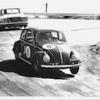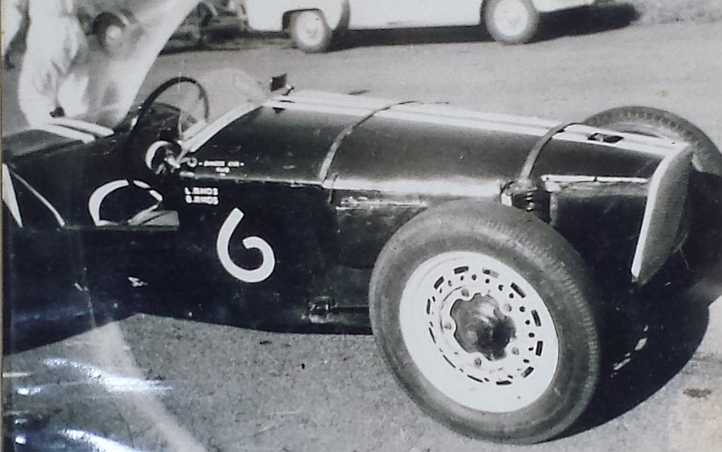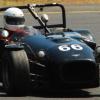Time for a closer look...
I wrote initially, "I was quite surprised to read a note on the back of it. Something along the lines of, "Guy took one of his cars to the Australian Grand Prix meeting at Albert Park in 1956 and won the main Sports Car race."
Here it is from the back of the book, one of which I was able to look at last week:
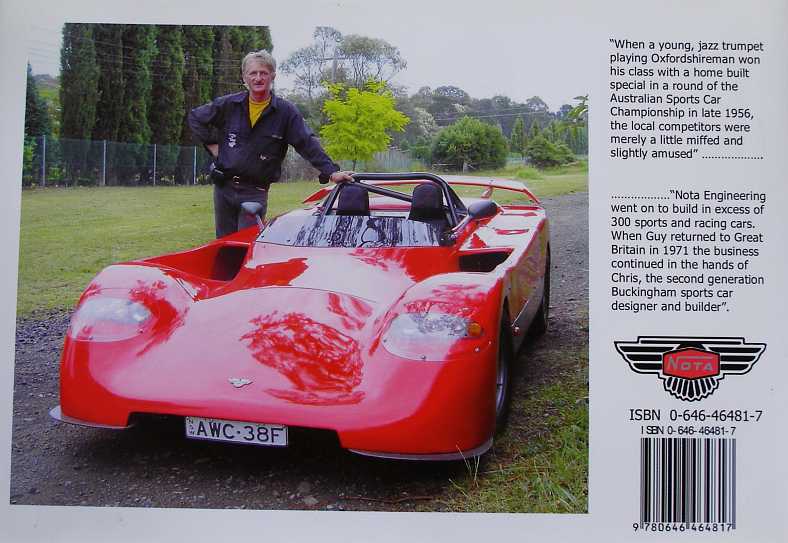
Obviously, for this to be true - ie. the statement, "When a young, jazz trumpet playing Oxfordshire man won his class with a home built special in a round of the Australian Sports Car Championship in late 1956, the locals were merely miffed and slightly amused..." - then I'd expect to find something in my
AMS race reports. Wouldn't I?
So I started looking. I began with the June, 1956, issue and went through issue by issue, looking at every race report that might - even obscurely - have provided me with any clues as to what this statement is really about.
We have some basic information that means the search must be broad. First, there was no Australian Sports Car Championship in 1956 and therefore no rounds of a championship. This was why my initial question related to the Australian Tourist Trophy, as that was the 'Championship' instituted in that year. It just didn't have 'rounds', it was a single race.
The first mention I found about Guy was in
Spotlight in the October issue. But let's not put the cart before the horse here, let's look at the racing scene into which Guy was finding his way.
There were TC Specials aplenty, including the 'Wheeler Fortune' with its mid-engine layout. In the June
Spotlight column we have a comment from Bob Pritchett that Col James had been in a conflict with James Madsen in his Cooper, the description of this implies that damage was done to the Barclay MG James was piloting.
In August's column, Bob mentions a new car being built by Jack Pryer (sic?) for John Archibald - "
reputed to weigh 9½ hundredweight angry, this machine has a chassis of box section (like the early Coopers), with independent front suspension on the Cooper system, its rear axle on radius rods, Panhard bar and coil springs, the box frame reinforced by an integral body frame of square steel tubing, and the engine which Rex Daniel has developed over a period to drive it faster and faster." This was a developing segment of our motor sport of the time.
James was back at Mt Druitt for the late-winter meeting but had problems with his car while dicing with Ian Steele's TC Special and the Lotus 6 of Doug Chivas. It would seem, however, that he was biding his time as a new car was being built.
October's
Spotlight sees Bob report the following regarding Bathurst prospects:
"
Doubt was also being entertained by Col James whether he would be performing at Bathurst - for one thing his new car might not be ready, and for another, Col has been a very sick boy - appendicitis, apparently proceeding normally, but then one of the stitches developed an abscess and peritonitis set in, laying him low for almost six weeks. He is still shaky and gets tired very easily so thinks that Bathurst may be out.
His new car, which will used the old engine, will use the front and back ends of the car he bought from Ray Revell (built originally by Nat Buchanan), namely transverse independent leaf at the front and De Dion back, to be joined together by a space frame, designed by an Epping (N.S.W) character who learned the tricks from Colin Chapman, they say, but there isn't all that much time left before Bathurst and it doesn't do to go off half cocked on these matters."
Following Bathurst, where the car won the under-1500cc Racing Car event, Bob reported this:
"
The new James car looks very pretty even if its body is not properly finished yet; Col had no difficulty at all in winning the under 1,500 scratch race but, partly due to the fact that they set the caster angle with one set of back wheels and spring, then put in a flatter back spring and fitted smaller wheels, thus making it singularly hard to handle, and partly due to not having a proper screen or a front to the bonnet so that Col was sitting in a 120 m.p.h. gale, which upset him a bit as he was still not properly well after his bout of illness; what with one thing and another he was so busy coping with distractions during the hundred miler that he managed to oil plugs a couple of times, so gave it away.
He was, however, tickled pink with the car, and says it will be a beauty when the odds and ends have been tidied up. Guy Buckingham, who dreamed up and built the space frame, has (I am informed by reader Crewe*) had many enquiries about chassis, both sports and racing, for M.G. and Holden motors, from a number of well known drivers. The gear shift linkage on the Barclay M.G, very similar to that on a Cooper-Bristol, was made by Mike Martin, who helped with the car's building."
* One of Bob's regular informants.
In the race report for the September 30, 1956, Bathurst meeting it's commented:
"
The Barclay M.G. had undergone a complete face lift, as related from time to time in these columns, and appeared as virtually a new car, with space frame, independent front and de Dion rear suspension, and quite a sightly body, designer and builder Guy Buckingham dancing attendance."
Not so good was the result at the November 11 Mt Druitt meeting, however:
"
Last for the season, the November meeting at Druitt was largely uneventful except for poor Col. James' tremendous prang, in which he just about wrote off the new car and busted some of his ribs - it happened on the Sweeper, where tar was starting to come through the surface (it had been made a no passing area once again) and nobody seems to know just what happened except that Col. rolled a good four times and was a very lucky boy....."
The crash had occurred in practice and was described in the race report: "
...in which the new car was ruined and Col. himself sustained injuries from which he's still recovering in hospital - at the time of going to press, no outside visitors were yet permitted to see him. As far as can be ascertained, his car went out of control in the sweeping bend onto the airstrip, rolled three times, then went end for ends; Col. broke three ribs and a skull fracture was suspected, besides facial lacerations and other minor injuries."
Possibly this crash set back some of Guy's plans, potential orders might not have come through as a result. But if this didn't slow things down, the comment on page 79 of the March, 1957, issue would have demanded some second thoughts. Again, from
Spotlight:
"
Col James is just about back on deck again after his prang; later examination revealed a couple of cracked vertebrae that they hadn't cottoned onto earlier, so that he will be wearing a sort of harness for quite some time, but otherwise he is pressing up well. Vital parts of his car such as the motor, radiator, tank, and difficult bits of bodywork are comparatively unharmed but the frame is a complete writeoff - as it seemed that it would never be made to handle, this may be no great loss. Col is at present taking an understandably jaundiced view of the proposition that he should continue racing when he is completely recovered, but may be brought to see the light - we can ill afford to lose a driver of his quality, and wife Jocelyn is all in favour of his return tot he ranks, so if his car can be rebuilt in a manner that will make it reasonably certain that it will go where he points it, we can only hope for the best."
In the September, 1957,
Spotlight Bob writes that Bill Reynolds had a drive of the Doug Chivas Lotus 6, liked it and bought it. Then he says:
"
Reynolds is to drive the Barclay MG for Col James for a while - although Col is much better than he was and in most respects is almost back to normal, he thinks that five minutes in the Barclay with its TC suspension would probably go so close to breaking his back again that he would be laid up for another few months."
Clearly, Guy and Col James had no more to do with each other. In fact, it's not until May, 1958, that Guy and/or Nota get another mention, that's on page 231 in the Silverdale Hill Climb report:
There, on page 231 it lists K. Bradburn as coming eighth in his class in a Nota Ford with a time of 56.39. In the narrative it mentions the first-timers:
"
Three interesting Specials appearing for the first time on the hill were Bradburn's Neta (sic) Ford, a smooth little Ford 10 Special, vaguely Lotus-like....." and "
Bradburn's quite pretty little Nota-Ford was much quicker than it had been in practice and spun going out of the first corner during the rain, bur was allowed to have another go."
At the October Bathurst, the AGP meeting of 1958, John Schroder's Nota Consul's performance is mentioned briefly. I found no mention of this car in Garner's hands, but it is a Racing Car and not really what I was looking for.
Things were starting to happen for Guy by the end of 1958, it seems, even though it's two years after the 'late 1956' quote from the book. At the Foley's Hill event of November 16 (page 557) it records that Guy went well:
"
A surprisingly good time for a Morris Minor Special of 30.3 secs. was registered by Guy Buckingham in his very pretty Lotus-style machine by name of NOTA, of which he is the originator."
A picture of the car at that event shows it to be one of the streamliners:
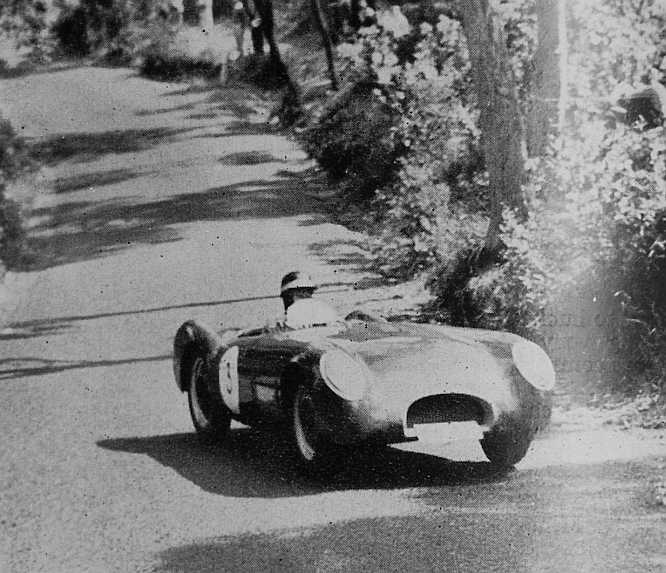
Guy placed second in the under 1,500cc Sports Cars class behind John Evans' TC, on the same day John Schroder was third among the Racing Cars with a time of 29.0.
The next Nota mention was at the January Gnoo Blas meeting where Brian Schroder came third on scratch and second on handicap in the last race of the day after dicing with Bill Cooke's Peugeot Special and Alwyn Rose.
We are now delving into reports from 1959, where I'll admit that
AMS became a bit less detailed. Foley's Hill on February 8 saw Alec Lazich second in the 1,500 Sports class in his Nota, in March at the same venue Bill Newcombe in his Nota Singer was unplaced on his first competition appearance.
Guy turned out again for a Sprint event held on the road at the top of Foley's Hill in April, recording a very consistent 20.0 seconds on each run to be unplaced, but for comparison we see that George Murray did 19.8 seconds with his Austin 7 Special.
As you can see, I've spent a lot of time looking for the elusive event where Guy won his class (even if it was not in late 1956) and impressed everyone. It just isn't there, at least not in a major event. We do know from John Medley's Bathurst book that Guy raced there in the NSW Road Racing Championship for Sports Cars in October that year and failed to finish.
Once again I'll try to impress upon readers, the point of all of this is that Nota did some good things, so there is no need for them to be made
larger than life!
In this 'Historical Research' corner, it harms their credibility if anyone tries to do that...
.
Edited by Ray Bell, 17 December 2015 - 03:46.





